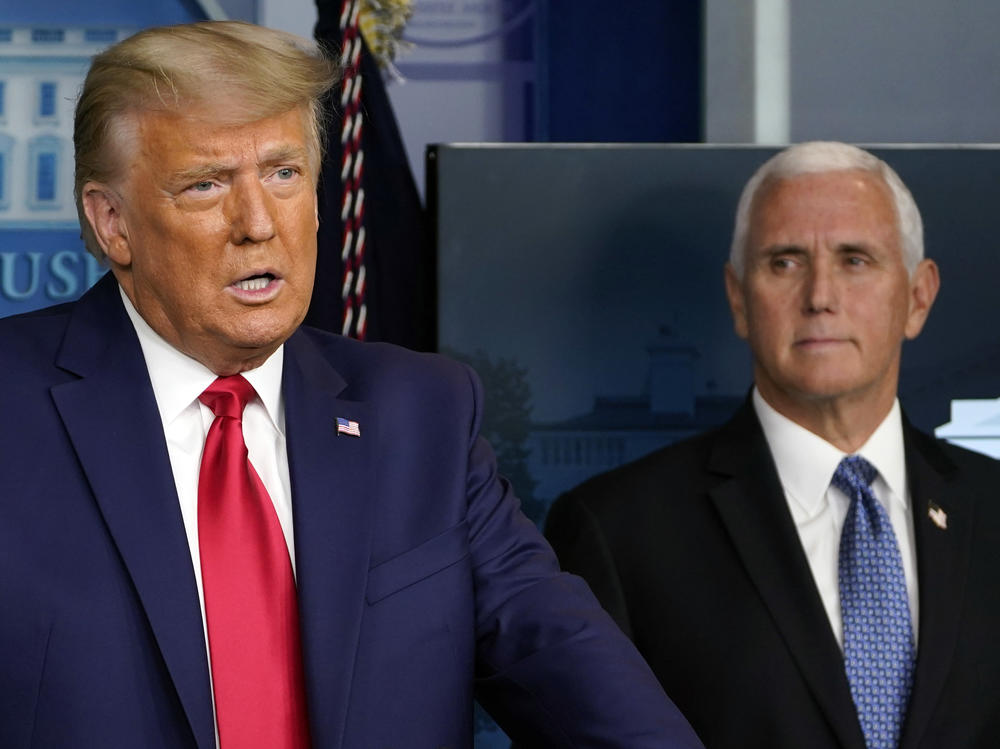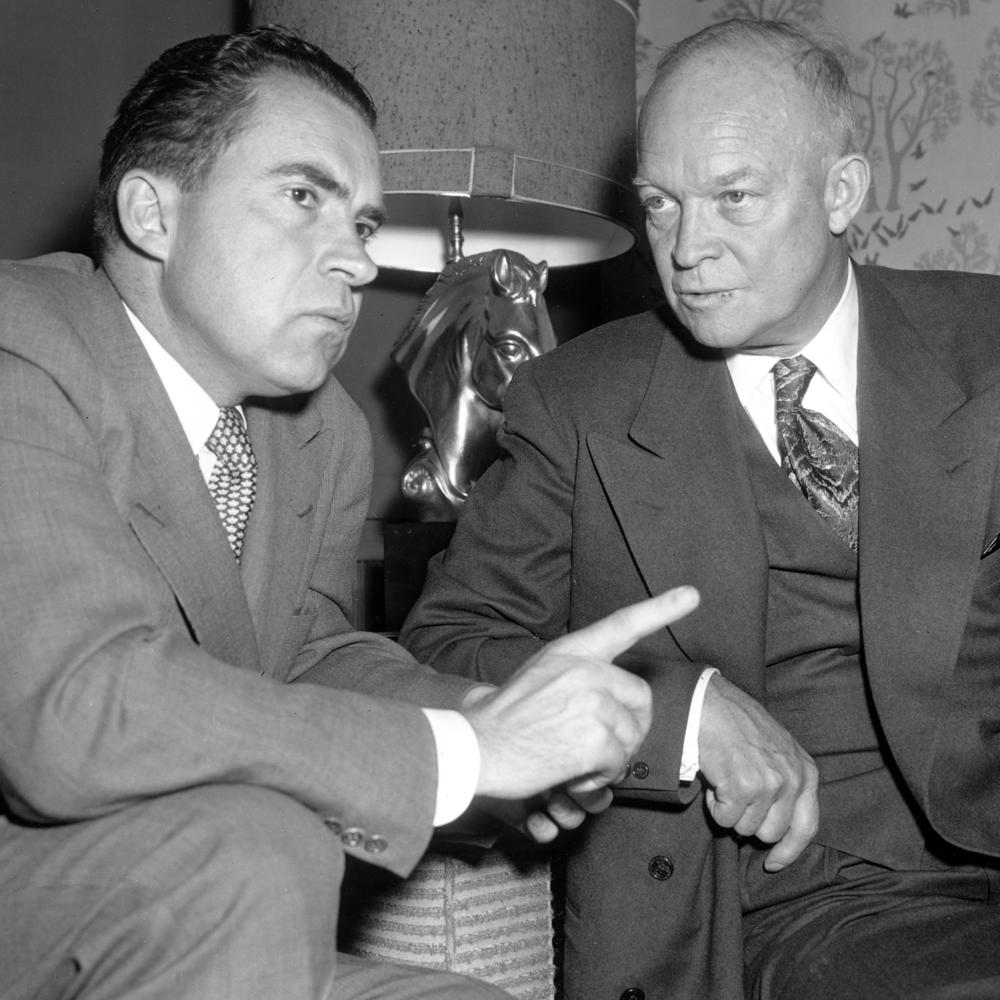Section Branding
Header Content
What The 25th Amendment Says About Removing A Sitting President
Primary Content
Updated on Jan. 7 at 1:55 p.m. ET
After the violent takeover of the U.S. Capitol, calls have continued to grow from Democrats and Republicans in Congress, as well as former U.S. officials, for Vice President Pence to invoke the 25th Amendment to the Constitution and assume the powers of the presidency.
Wednesday's rioting was caused in large part by President Trump's rhetoric, experts say, and even after the Capitol was swarmed, Trump refused to condemn the mob, instead telling them in a video they were "very special."
That's led lawmakers to consider the easiest way to rid a president of his powers.
"The quickest and most effective way — it can be done today — to remove this president from office would be for the vice president to immediately invoke the 25th Amendment," Senate Minority Leader Chuck Schumer said in a statement Thursday.
House Speaker Nancy Pelosi also echoed Schumer's call Thursday that the 25th Amendment be invoked.
"If the vice president and Cabinet do not act, the Congress may be prepared to move forward with impeachment," Pelosi told reporters.
Republican Rep. Adam Kinzinger of Illinois tweeted a video urging Pence to act "to ensure the next few weeks are safe for the American people, and that we have a sane captain of the ship."
It's become a frequent topic throughout the Trump presidency, but the 25th Amendment has never actually been used before to take powers away from a president without his consent.
The amendment provides a framework for how that scenario should play out, but legal experts have spent decades wondering about the potential "constitutional crises" that could follow.
What the law says
The language of the amendment says if the vice president and either a majority of the executive Cabinet or a review body appointed by Congress declare in writing that the president is unfit for office, then the vice president immediately becomes the acting president.
But the law also gives the sitting president, Trump in this case, the chance to argue that he is fit for office.
In the case of competing arguments about the president's ability to lead, "Congress shall decide the issue," the amendment says. For the vice president to assume the power of the presidency, two-thirds of both the House of Representatives and Senate must vote in favor of that outcome.
If Congress does not have the sufficient majorities in both parties in favor of rescinding the president's power, then he remains in power.
At the time it was passed, the amendment was not intended to "facilitate the removal of an unpopular or failed President," according to a Congressional Research Service report. And such a move, the report says, could potentially "precipitate a constitutional crisis."
"[It's a] ... sort of nightmare scenario that scholars describe as contested removal, in which a president would object to the idea that he's been determined to be unwell," writer Evan Osnos said in an interview on NPR's Fresh Air in 2017. "It's kind of amazing to step back and think about what that would actually be like in practice, that you would have Congress actively, openly, publicly discussing the question of whether or not the president of the United States was mentally fit to return to the presidency."
How the 25th Amendment came to be
When he left office in 1961 at the age of 70, Dwight Eisenhower was the oldest president in U.S. history. And he had battled health problems. In his first term, Eisenhower suffered both a heart attack and a mild stroke, leaving a nation already jittery from Cold War tensions even more so.
He and his vice president, Richard Nixon, agreed to an arrangement in which Eisenhower would temporarily cede power should he again be incapacitated, but would himself determine when to reassume his duties.
It was an ad hoc agreement that left unaddressed a scenario in which the president is incapable of determining his fitness for office.
When the oldest-serving president was succeeded by John Kennedy, the youngest-elected president, concern over the issue "arguably eased," according to Thomas Neale of the Congressional Research Service.
That is, until Kennedy's assassination.
Article II, Section 1, Clause 6 of the Constitution says the vice president assumes the "powers and duties" of president in the event of the president's "inability," but it doesn't say how to determine the president is unable to serve.
Had Kennedy remained alive, but incapacitated, there might not have been a way for Vice President Lyndon Johnson to serve as acting president.
Hence the 25th Amendment to the Constitution, passed by Congress in 1965 and ratified in 1967 when Nevada became the 38th state to approve it. Sections 3 and 4 of the amendment fill that constitutional gap: how to ensure the nation has a chief executive when the president is incapacitated.
Section 3 addresses the simplest scenario: when a president determines he is incapacitated, and later determines he is able to return to the duties of the office. The president, in writing, informs the speaker of the House and the president pro tempore of the Senate of his incapacity and informs them again in writing when ready to resume. The vice president serves as acting president in the interim.
According to Neale of the Congressional Research Service, Section 3 has been invoked three times:
- President Ronald Reagan arguably did so when he underwent cancer surgery in 1985 and put Vice President George H.W. Bush temporarily in charge (though Reagan maintained the drafters of the amendment didn't intend it to be applied in such a circumstance).
- President George W. Bush formally invoked the amendment twice, in 2002 and 2007, while undergoing routine colonoscopies.
Section 4 addresses the aforementioned much more complex scenario: when a president is incapable of declaring his incapacity.
Below is the full text of section 4 of the amendment:
Whenever the Vice President and a majority of either the principal officers of the executive departments or of such other body as Congress may by law provide, transmit to the President pro tempore of the Senate and the Speaker of the House of Representatives their written declaration that the President is unable to discharge the powers and duties of his office, the Vice President shall immediately assume the powers and duties of the office as Acting President.
Thereafter, when the President transmits to the President pro tempore of the Senate and the Speaker of the House of Representatives his written declaration that no inability exists, he shall resume the powers and duties of his office unless the Vice President and a majority of either the principal officers of the executive department or of such other body as Congress may by law provide, transmit within four days to the President pro tempore of the Senate and the Speaker of the House of Representatives their written declaration that the President is unable to discharge the powers and duties of his office. Thereupon Congress shall decide the issue, assembling within forty-eight hours for that purpose if not in session. If the Congress, within twenty-one days after receipt of the latter written declaration, or, if Congress is not in session, within twenty-one days after Congress is required to assemble, determines by two-thirds vote of both Houses that the President is unable to discharge the powers and duties of his office, the Vice President shall continue to discharge the same as Acting President; otherwise, the President shall resume the powers and duties of his office.
A version of this story was first published on Oct. 2.
Copyright 2021 NPR. To see more, visit https://www.npr.org.


